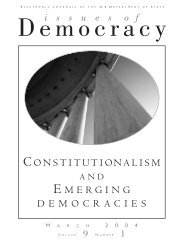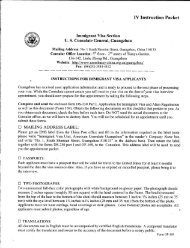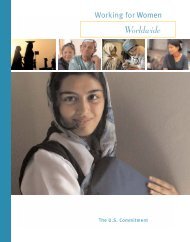Terrorism: Threat Assessment, Countermeasures and Policy
Terrorism: Threat Assessment, Countermeasures and Policy
Terrorism: Threat Assessment, Countermeasures and Policy
Create successful ePaper yourself
Turn your PDF publications into a flip-book with our unique Google optimized e-Paper software.
emergence of a largely healthy middle <strong>and</strong> upper class,<br />
public health in the 1970s did not seem a high priority<br />
in an era of budget cuts. Today, the public health<br />
system across the United States barely has enough<br />
funding, staff, <strong>and</strong> other resources to manage day-today<br />
issues, much less crises caused by either natural<br />
outbreaks or bioterrorism. The United States simply<br />
does not have the capacity to manage a disease outbreak<br />
affecting hundreds or thous<strong>and</strong>s of people.<br />
At the international level, there are very few tools that<br />
are effective against the bioterrorist threat. The 1972<br />
Biological <strong>and</strong> Toxin Weapons Convention (BWC) is<br />
the main international treaty governing biological<br />
weapons. Other mechanisms exist, such as the<br />
Australia Group, which attempts to provide guidelines<br />
for technology exports related to biological weapons<br />
production. But the Australia Group has limited<br />
enforcement power <strong>and</strong> does not include certain key<br />
states of concern. In addition, the Group limits only<br />
relatively large-capacity equipment; this does not<br />
address the possibility of smaller-scale cl<strong>and</strong>estine<br />
production. The BWC itself has no enforcement of<br />
verification regime, <strong>and</strong> although a draft Protocol was<br />
submitted to the BWC’s Conference of States Parties<br />
this year, the United States refused to sign the<br />
document, effectively halting work on augmenting the<br />
treaty’s ability to enforce its provisions. A BWC<br />
Review Conference is scheduled for November 2001,<br />
although it is unclear whether there will be any more<br />
progress toward a verification agreement.<br />
However, even with U.S. signature <strong>and</strong> a completed<br />
Protocol, it is far from clear that the BWC would do<br />
anything in the fight against bioterrorism other than<br />
help to build <strong>and</strong> strengthen the international norm<br />
against biological weapons. Indeed, the treaty text does<br />
not address terrorism but focuses instead on the threat<br />
from states.<br />
At the national policy level, the concepts of deterrence<br />
<strong>and</strong> foreign policy that were so useful during the Cold<br />
War do not apply to the threat of bioterrorism. When<br />
the adversary is an elusive network of enigmatic diehard<br />
operatives completely dedicated to their cause, it is<br />
nearly impossible to design a strategy to respond.<br />
Terrorists rarely have targetable assets, either financially<br />
or militarily. Efforts to freeze terrorist financial<br />
assets are hampered by the vastness of the international<br />
banking system, <strong>and</strong> only in cases where states are<br />
supporting terrorists is it possible to find a military<br />
target. All attempts to destroy al-Qaida’s infrastructure<br />
are laudable, <strong>and</strong> the United States should continue to<br />
pursue the perpetrators of the September 11 attacks.<br />
But it is crucial to remember that these efforts have<br />
limited value.<br />
In sum, the vulnerability of the United States to<br />
bioterrorism, the lack of effective international means,<br />
<strong>and</strong> ingrained Cold War foreign policy concepts make<br />
responding to the bioterrorist threat exceedingly<br />
complex <strong>and</strong> challenging.<br />
POLICY RECOMMENDATIONS<br />
Policies to address the bioterrorist threat come in three<br />
broad categories: addressing terrorism generally,<br />
responding to a mass-casualty bioterrorist incident<br />
specifically, <strong>and</strong> maximizing all available international<br />
options.<br />
The United States should continue to use all means at<br />
its disposal to eliminate the current terrorist threat from<br />
al-Qaida <strong>and</strong> related organizations. This includes<br />
raising the costs of sponsoring terrorism so high that<br />
terrorists will not be able to operate easily; maximizing<br />
intelligence operations directed against terrorism; <strong>and</strong><br />
making it clear that terrorism is unacceptable, in order<br />
to deter future attacks. In addition, the United States<br />
should work very closely with its international partners<br />
to coordinate efforts designed to reduce the biological<br />
weapons threat. Security will be increased if the taboos<br />
against biological weapons are strengthened <strong>and</strong> the<br />
international community works together to address<br />
the threat.<br />
There are limits to what the United States can do<br />
nationally <strong>and</strong> internationally to address bioterrorism.<br />
Therefore, policymakers should accept that it is<br />
impossible to eliminate completely either the terrorist<br />
threat or the threat from bioterrorism. It is therefore<br />
highly critical that the United States prepare itself to<br />
detect <strong>and</strong> respond to a bioterrorist incident.<br />
This includes steps to:<br />
27












